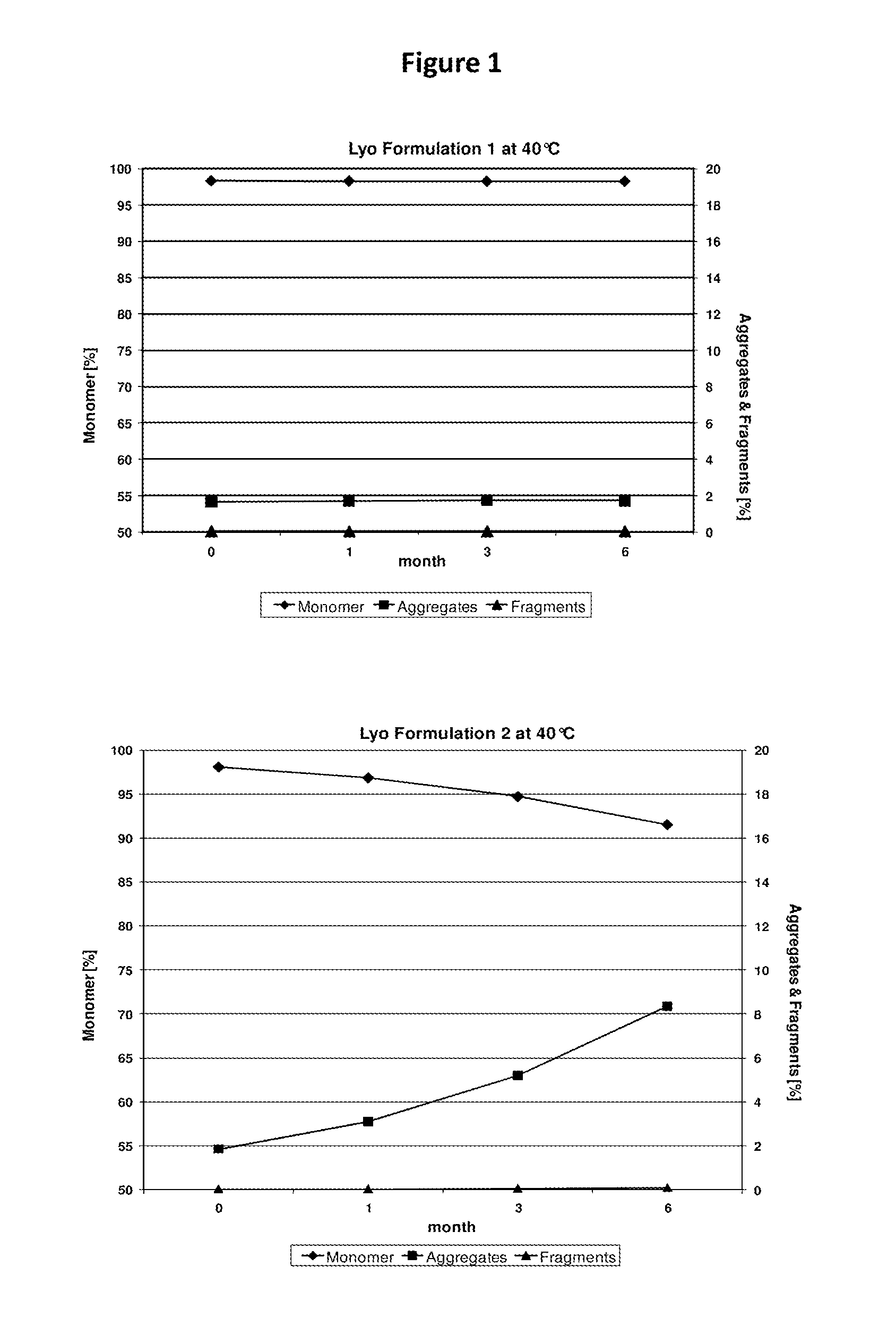Anti-nerve growth factor (NGF) antibody compositions
a technology of growth factor and anti-nerve, which is applied in the field of anti-nerve growth factor (ngf) antibody compositions, can solve the problems of physical instability of the antibody in the formulation
- Summary
- Abstract
- Description
- Claims
- Application Information
AI Technical Summary
Problems solved by technology
Method used
Image
Examples
example 1
Impact of Solution pH on The Stability of PG110 Formulations During Repeated Freeze / Thaw Studies (−80° C. / 30° C.).
[0224]The freeze thaw behavior of the ABT110 antibody at a protein concentration of 1 mg / mL in 10 mM citrate / 10 mM phosphate buffer was evaluated by cycling the protein solution up to 4 times between the frozen state and the liquid state at pH 4, pH 5, pH 6, pH 7, and pH 8. Freezing was performed by means of a temperature controlled −80° C. freezer, and thawing was performed by means of a 30° C. temperature controlled water bath. Samples were pulled after each freeze / thaw (F / T) cycle and analyzed by SEC. About 20 mL of each PG110 solution was placed in 30 mL PETG repositories for this experiment. Table 3 provides an overview on testing intervals for SEC and the number of freeze / thaw cycles performed. Table 4 shows the effect of freeze / thaw processing on the amount of monomer of PG110 remaining and the amount of fragments and aggregates formed in the samples formulated at...
example 2
Impact of Solution pH On Physico-Chemical Stability of PG110 Formulations During Accelerated Storage
[0227]Important factors influencing protein stability during accelerated / long-term storage of protein liquid and lyophilized formulations are the pH of the formulations and the storage temperature. To assess the impact of these factors, the protein was exposed to short-term storage at elevated temperatures during preformulation and formulation project stages in order to quickly gain insight in the formulation feasibility for long-term storage at lower temperatures (e.g., 2-8° C.).
[0228]Storage stability of the PG110 antibody in solution (2 mg / mL, 10 mM citrate / 10 mM phosphate buffer) was evaluated at various temperatures for prolonged periods of time at controlled temperature conditions. After defined storage periods, samples were pulled and the impact of storage time and storage temperature on PG110 stability was evaluated.
[0229]For this pH screening study, PG110 was formulated at pH...
example 3
Impact of formulations on The Stability of PG110 Formulations During Repeated Freeze / Thaw Studies (−80° C. / 30° C.) at 30 mg / mL Conditions
[0234]The freeze / thaw (F / T) behavior of the ABT110 antibody at a protein concentration of 30 mg / mL in different formulations was evaluated by cycling drug substance up to 3 times between the frozen state and the liquid state at pH 5.5. The formulations that were evaluated are:[0235](1) 10 mM acetate+125 mM sodium chloride pH 5.5[0236](2) 15 mM Histidine pH 5.5[0237](3) 15 mM histidine and 0.01% Tween 80 pH 5.5
[0238]Freezing was performed by means of a temperature controlled −80° C. freezer, and thawing was performed by means of a 30° C. temperature controlled water bath. Samples were pulled after each freeze / thaw cycle and analyzed by SEC and visual inspection. About 1 mL of PG110 solution were placed in repositories for this experiment. Table 13 provides an overview on testing intervals for SEC and the number of freeze / thaw cycles performed. Table...
PUM
| Property | Measurement | Unit |
|---|---|---|
| concentration | aaaaa | aaaaa |
| concentration | aaaaa | aaaaa |
| molecular weight | aaaaa | aaaaa |
Abstract
Description
Claims
Application Information
 Login to View More
Login to View More - R&D
- Intellectual Property
- Life Sciences
- Materials
- Tech Scout
- Unparalleled Data Quality
- Higher Quality Content
- 60% Fewer Hallucinations
Browse by: Latest US Patents, China's latest patents, Technical Efficacy Thesaurus, Application Domain, Technology Topic, Popular Technical Reports.
© 2025 PatSnap. All rights reserved.Legal|Privacy policy|Modern Slavery Act Transparency Statement|Sitemap|About US| Contact US: help@patsnap.com


